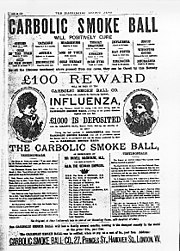| Carlill v Carbolic Smoke Ball Co | |
|---|---|
 | |
| Court | Court of Appeal |
| Full case name | Louisa Carlill v Carbolic Smoke Ball Company |
| Decided | 7 December 1892[1] |
| Citations | [1892] EWCA Civ 1, [1893] 1 QB 256 (CA) |
| Case history | |
| Prior action | Carlill v Carbolic Smoke Ball Co [1892] 2 QB 484 (QBD) |
| Subsequent action | none |
| Court membership | |
| Judges sitting | Lindley, Bowen and AL Smith |
| Case opinions | |
| All three Lords Justices of Appeal | |
| Keywords | |
| Advertisements, Conditions, Insurance, Offer and acceptance, Wagering contracts | |
Carlill v Carbolic Smoke Ball Company [1893] 1 QB 256 is an English contract law decision by the Court of Appeal, which held an advertisement containing certain terms to get a reward constituted a binding unilateral offer that could be accepted by anyone who performed its terms. It is notable for its treatment of contract and of puffery in advertising, for its curious subject matter associated with medical quackery, and how the influential judges (particularly Lindley and Bowen) developed the law in inventive ways. Carlill is frequently discussed as an introductory contract case, often one of the first cases a law student studies in the law of contract.
The case concerned a flu remedy called the "carbolic smoke ball". The manufacturer advertised that buyers who found it did not work would be awarded £100, a considerable amount of money at the time. The company was found to have been bound by its advertisement, which was construed as an offer which the buyer, by using the smoke ball, accepted, creating a contract. The Court of Appeal held the essential elements of a contract were all present, including offer and acceptance, consideration and an intention to create legal relations, and rejected a number of defenses, including puffery.[2]
- ^ "BAILII - 1892 England and Wales Court of Appeal (Civil Division) Decisions".
- ^ Jackson, Nicola (1 September 2019), "Carlill v Carbolic Smoke Ball Co [1893] 1 QB 256", Essential Cases: Contract Law, Oxford University Press, doi:10.1093/he/9780191883750.003.0007, ISBN 978-0-19-188375-0, retrieved 31 January 2024